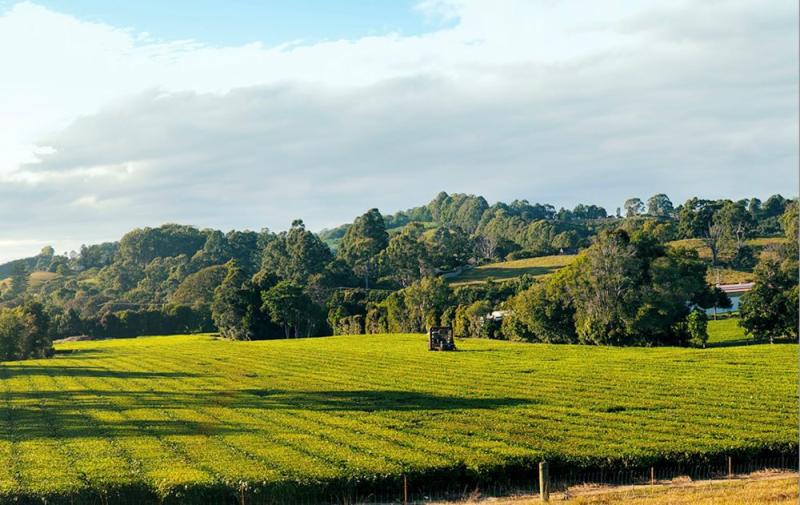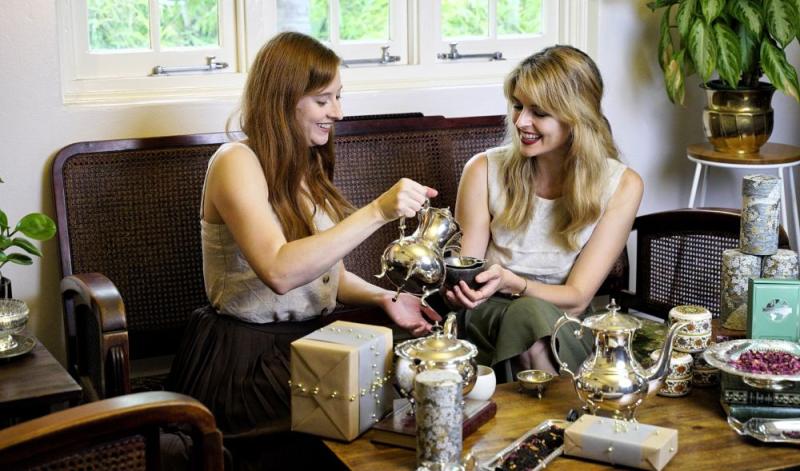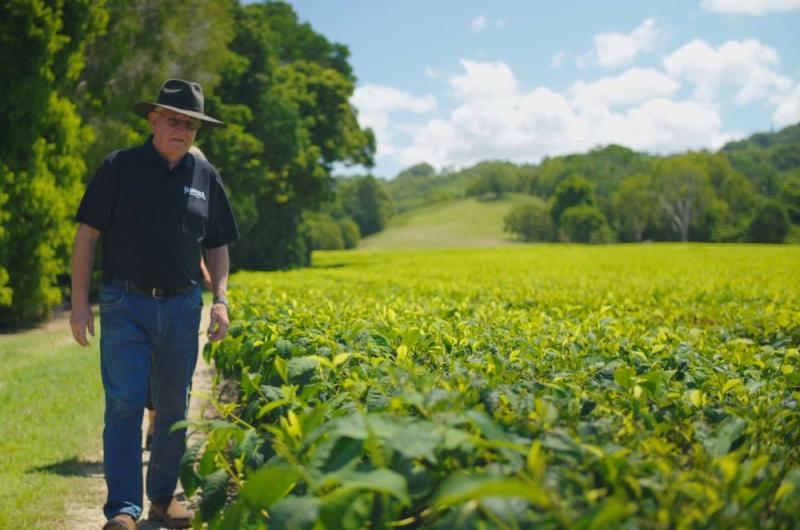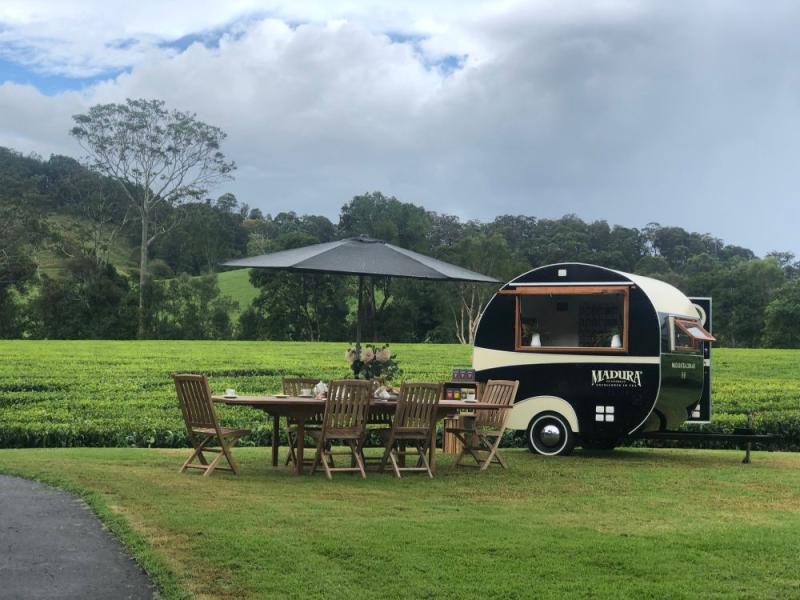Welcome to Part 1 of our new, three-part series on the Australian tea market. In this installment, we'll explore the British and Irish influence on Australian tea.
While it is common knowledge that the habit of tea drinking in Australia came from the British, it is a little-known fact that the harvesting of tea on the continent owes much to the involvement of an eccentric Irishman named Michael Grant-Cook.
Having been trained in tea cultivation and production in India and Sri Lanka, Grant-Cook moved South, establishing tea plantations in sub-tropical regions where owners would take him up on his dreamy offer to transform the vistas of their barren terrain into tea fields as far as the eye could see. From Papua New Guinea to Australia to Hawaii, USA, the late Grant-Cook charted a tea trail that is perhaps unrivaled in its reach among those who’ve planted the bush.
Establishing Madura Tea Estate in New South Wales, Australia, in 1978, the tea-obsessed Irishman reinvigorated land that had previously been used as a dairy farm. Located within a large cauldron-like hollow blanketed with long-cooled and weathered magma from an extinct volcano raging millions of years ago, Grant-Cook found the terroir and altitude to be almost tailor-made for raising tea. Within just three years, he had coaxed young but viable tea plants out of the fertile soil. (Normally, it takes five to eight years for this achievement.)
Today, Madura Tea Estate is run by Garey Davey with the help of his partners. Davey, the managing partner, along with Natalie Loemker, who heads sales and marketing, and Carsten Loemker, in charge of engineering and electrical as well as a silent partner, pooled their resources to buy the property some twenty-six years ago. They’ve been harvesting, processing, blending, packing, and labelling the plantation’s tea, all on the same premises, ever since. There are few tea farms, globally, which are so integrated; it’s an achievement of which Davey and the Loemkers are rather proud.
As well they should be, for Australia is not known as a panacea for the humble tea planter. Rather, home to lush rainforests, expansive deserts, and temperate highlands, the land “Down Under” is a fascinating continent with terrain that supports a diverse agricultural profile. From growing broadacre wheat, producing wool, and ranching cattle to establishing vineyards and nurturing organic farms, working the land has long been a pillar of Australia’s economy and identity. Over time, this activity has evolved from traditional to sustainable and organic practices.

A Confederacy of Sippers & Slurpers
There wouldn’t be any tea farms on the continent if not for the presence of tea-drinkers. Still, getting Australians to choose premium tea the way they have embraced premium and specialty coffee poses both challenges and opportunities.
Sharyn Johnston, a prominent Australian tea retailer, educator, and CEO and founder of Australian Tea Masters, says that heritage still profoundly influences the Australian palate.
"[We were definitely] black tea drinkers for years and years and years,” Johnston says, lamenting the prominence of English Breakfast and other standard teas. “Tea drinkers are sick, worldwide, of walking into a cafe, a really good cafe or a good restaurant, and getting offered English Breakfast, Earl Grey, chamomile, and peppermint.
"That's about the limits, and I've stood up and said that you know, English breakfast is a ruination of the tea market. It's why the teas are still cheap,” Johnston adds, mentioning that there are so many very good black teas on the market before one even gets into green teas and other varieties.
Moreover, she bemoans the association of tea as a cheap drink in pre-empting the experience of premium whole leaf tea from being part of people’s daily routine the way coffee is now.
Looking forward to the day when specialty tea reaches the heights of specialty coffee, Johnston remarks on the exceptional nature of the industry in Australia. “We are very unique in Australia,” she asserts. “With our coffee industry, we have more specialty coffee roasters, I think, than per head population than most countries.”
She says Starbucks never gained a real foothold in Australia because of the strength of the local specialty roasters and retailers. As a prominent member of the tea industry, she has aspirations for it to mirror the achievements of the coffee industry in Australia.
While Johnston’s business exists on almost an industrial level, creating blends and powders for wholesalers and large tea/beverage companies, sisters Hannah and Amy Little, lie at the other end of the spectrum, co-owning a tea boutique in Brisbane called Tour de Tea, which has become known as the city’s “favorite little tea shop.” While admitting it’s a challenge, and agreeing with Johnston that the tea market is driven by price, Hannah Little says it’s a matter of how the price of tea can be communicated to the consumer on a cup basis.
“In Australia, current cost of living pressure is crippling for a really large portion of society," says Hannah. "So, spending a little more to change-up your tea routine from grocery store bags to high-quality loose-leaf isn’t something that everyone is going to consider. That being said, the price of fine loose-leaf tea per cup is still cheaper than a bottle of soft drink or juice. So framing it that way can help with that shift.”

The pair have also found innovative ways to engage their clientele with tea. “There is perhaps no other food item or beverage, which can underscore a moment in someone’s life more than tea,” Hannah says.
The desire to create such memorable moments has given rise to a “Paint and Sip” workshop from Tour de Tea. In the workshop, people learn about tea alongside painting. Fusing art with artisan tea links parts of the brain responsible for creativity with the appreciation of different flavor profiles that tea has to offer. The classes constitute a way of crafting an experience around tea, which brings the beverage into people’s lives in an entirely new way.
Hannah’s description sounds much like Teaism, once a vibrant Japanese philosophical movement that relied upon tea to center one’s thoughts in the context of one’s surroundings while stirring creativity. As Okakura Kakuzo writes in The Book of Tea, “Tea is a work of art and needs a master hand to bring out it’s noblest qualities.”
“Our Paint and Sip workshops offer people the ability to engage with an in-depth tea tasting over the course of a two-hour lesson in watercolor. Tea and creativity have long kept amiable company, and we find our model of Paint and Sip offers a relaxing and mindful session without the necessity for alcohol, making it a thoroughly inclusive space for anyone in the community,” Hannah says.

The key to appreciating it, the Littles assert, involves keeping an open mind. The sessions offer the sisters the opportunity to dialogue with their clientele, during which they provide information and field questions as they introduce people to a wide range of teas and expand upon their conceptions of tea.
The shop offers 52 varieties of tea from around the world, including locally grown Australian tea. It represents the culmination of the sisters’ thirty-plus years of combined experience in the industry.
While Amy has worked in the finest tea rooms of Paris and London, Hannah has made trips to the tea-growing areas of Sri Lanka, Malaysia’s Highlands, and Japan, and she has also lived in Queensland, Australia where she became familiar with Australian Teas. One of Hannah's first exposure to the local market was at Arakai Estate (the owners of whom we’ll meet in the next part of this series), located just a 90-minute drive from their store. However, for many, Madura Estate typifies the earliest days of commercial tea in Australia.
Madura Tea Estate
Madura Tea Estate has come a long way since the days of the tea-obsessed wanderer Michael Grant Cook.
With around ninety acres under cultivation, the estate now grows, processes, blends, and packages their teas all at the same site. However, unlike other producers, they are focused on marketing tea under their label rather than selling it wholesale.
“This business was built on taste, like most good brands are built on taste; and we've been great believers that you get what you pay for in terms of tea,” says Managing Partner Gary Davey. “We do all the normal, you know, pre-shipment, sample testing, and all of that sort of thing.”

The Madura team not only sells their tea in 100% Australian form, but they also blend their Australian tea with Indian, Sri Lankan, and other teas when they want to achieve a certain flavor. “It's all about a taste profile," says Davey. "Some of our blends have six different teas in them. So, we can balance the taste profile up if the tea is not to what it was last time,” Davey says.
As a professional operation banking on the reputation of their label, it’s all about maintaining consistency and high quality for their discerning clientele.
Their label is available in loose leaf form and bags in most major supermarkets in Australia such as Coles, Woolworths, and IGA – and Davey says they’ve made quite an impact on the market. “Our premium blend leaf tea is pretty much the market leader in terms of dollars in the country. Our bags are not far behind it,” he asserts.
Madura does both Crush Tear Curl (CTC) tea and orthodox leaf, and likens the product to what comes out of Assam in India. “We’re about the same distance south of the equator as what the Assam district is north of the equator. So, they're the type of growing conditions that we have here,” Davey explains.
I ask Davey about the flavor of the tea – whether they’re catering to the strong English Breakfast fans, which still seem to dominate the market in Australia. (Indeed, the English Breakfast blend was first produced from broken Assam leaves – a region to which Davey says his garden has some affinity, geographically, at least.) He differs, insisting that the Australian market is changing just as is being observed in other former British colonies. “Well, we used to have about 85% of people drink their tea with milk and sugar, but that's now down to about 55%. So, there's been a big trend away from sugar – and, to some degree, milk as well,” Davey observes.
The estate’s harvesting season runs from September until mid-March, sometimes as late as April, and they get flushes like other plantations. A diverse set of cultivars have emerged from the tea garden quite by happenstance.
“The interesting thing is, we had Camellia sinensis [var.sinensis or China Bush], obviously. And, when they planted out, they planted [Camellia sinsensis var.] assamica as well. So, we kind of have a hybrid version here now, because over the years it's started to cross-pollinate,” Davey explains. This is not unusual where the two species have been planted in the same garden; the integration of genetic characteristics is natural, and the result is a tea that is both fragrant and full-bodied.
“So, it's really an interesting flavor profile – our estate’s tea. The black tea has a real, soft, delicate flavor to it,” Davey describes. “The green tea is quite grassy.”
Davey says both the sinensis and assamica seeds were brought from India by the Irishman, Grant-Cook, and says the older bushes are over 40 years old.
“We also have a pretty unique green with Australian lemon myrtle blend,” Davey mentions. Lemon myrtle (or Backhousia citriodora for the serious botanical enthusiasts) is a citrus plant native to the sub-tropical rainforests of Queensland, which was used by aboriginals native to the continent for medicinal purposes over thousands of years, Davey explains. “It’s one of those things that’s an anti-bacterial ‘cure-all’. I don’t know whether it does that or not, but it makes a hell of a nice cup of tea, especially in winter, if you've got a cold or a flu. It's quite a special blend that's very popular as well,” he adds.
Lemon myrtle blend, as it happens, is one of the Australian teas sold at Tour de Tea and promoted as a soothing infusion.
Davey was kind enough to provide this writer with samples of both pure lemon myrtle broken leaf and lemon myrtle blended with green tea. For the latter, the vegetal nature of the green tea is covered by a strong citrusy nose, making it quite a refreshing tea to drink. The combination yields a well-structured brew that doesn’t become bitter even after a long steep. The secret is in the lemon myrtle, which has a subtle honeyed character in its strong but pleasant citrusy aroma. A close comparison is to lemongrass. The pure lemon myrtle is a strong cup of citrus infusion, which lacks the bitter bite of lemon. It’s a mellow flavor with a smooth character and almost feels pre-sweetened.
One area Davey is focused on is getting the word out about their estate. They’ve created a professional video that is well suited for social media that begins to tell their story, but they see this as just the beginning.
“We haven't taken a really strong angle in terms of telling our story. And it's definitely a position that we're looking to improve on moving forward, because, you know, the Madura story is a really incredible story, and where the estate is located is really special,” Davey says. “We all feel really fortunate working here.”
It is safe to say that had Grant-Cook lived to see what Madura has become, he would likely look back with a good measure of pride.

Plan to Attend or Participate in World Tea Expo, March 23-25, 2026
To learn about other key developments, trends, issues, hot topics and products within the global tea community, plan to attend World Tea Expo, March 23-25, 2026 in Las Vegas, co-located with Bar & Restaurant Expo. Visit WorldTeaExpo.com.
To book your sponsorship or exhibit space at World Tea Expo, or to inquire about advertising and sponsorship opportunities at World Tea News, contact:
Ellainy Karaboitis-Christopoulos, Business Development Manager, Questex
Phone: +1-212-895-8493; Email: [email protected]
Looking for professional tea education, certifications, and more? Visit World Tea Academy and register for courses today!
Also, be sure to stay connected with World Tea Expo on social media for details and insights about the event. Follow us on X, Facebook, Instagram and LinkedIn.
